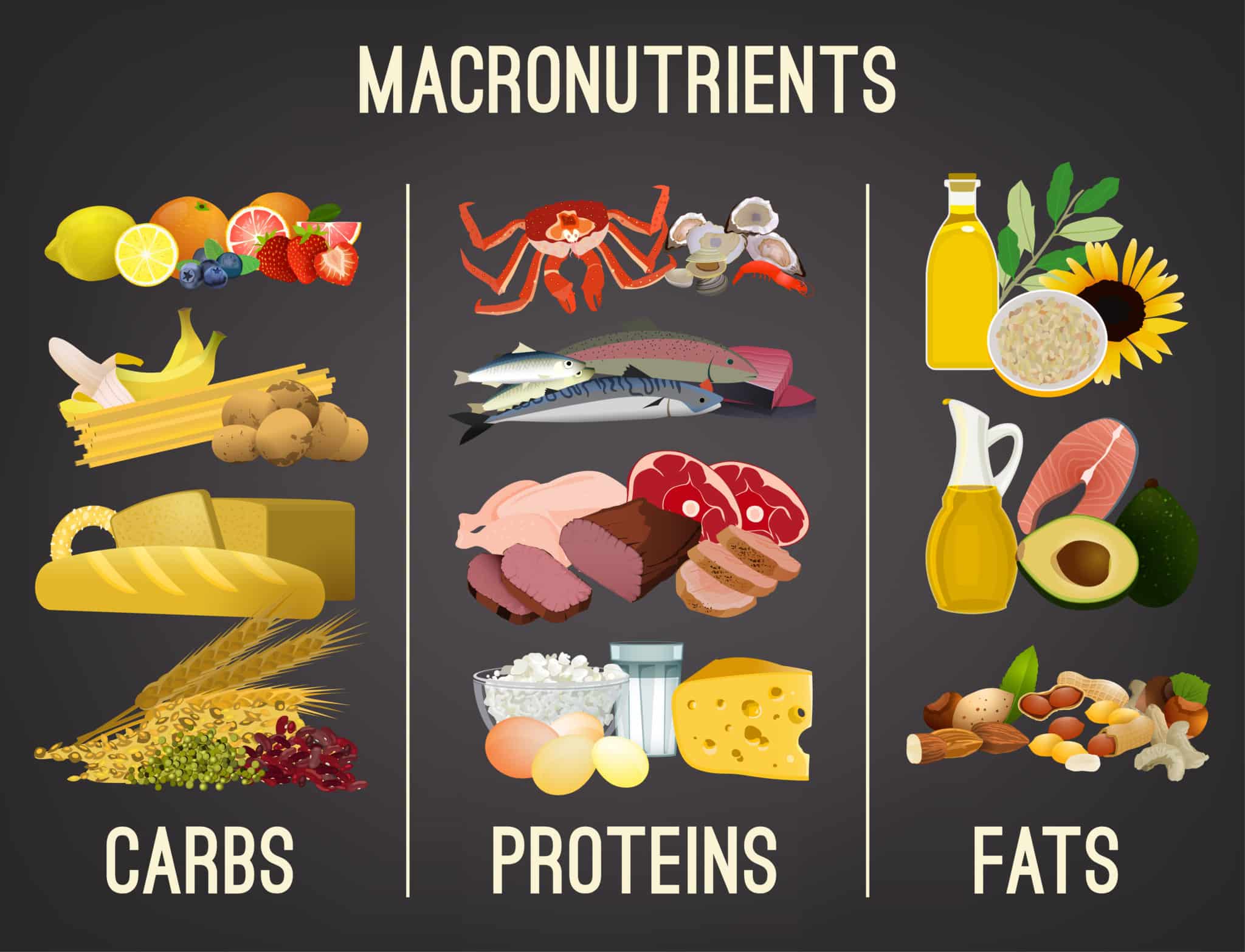You’ve likely heard people talk about “counting macros,” and if you’ve greeted that statement with a blank stare, you’re not alone. Macros (short for macronutrients) aren’t something most people learn about in school.
But more than counting calories or avoiding any one particular food group (unless you have a sensitivity,) counting macros is actually one of the best things you can do to eat intuitively and maintain a healthy weight. Sound intriguing?
Consider this your beginner’s guide to macronutrients: we’ll explore what macros are, how to count them, and why doing so may be better than any diet you’ve tried.
Use the links below to quickly navigate this guide:
- What are Macros?
- The Three Main Macros: Carbs, Protein and Fat
- Why Should You Count Your Macros
- How To Count Your Macros
What are Macros?
Macronutrients are defined as “substances required in relatively large amounts by living organisms.” The three primary macronutrients for humans are carbohydrates, protein, and fat—we need all three to function.
You’ve probably heard people discuss micronutrients as well. Micronutrients are IN your macronutrients. Those refer to minerals, vitamins, antioxidants and enzymes. If you eat a good mix of macros, you should then be getting a good mix of micronutrients.
Right now, we’re just focusing on the big guys: macronutrients.
Each of the three main macronutrients (carbs, protein, and fat) serve your body in a different way. Here’s a bird’s-eye-view of what each macronutrient does.
The Three Main Macros: Carbs, Protein, and Fat
Carbohydrates
Carbohydrates are your body’s preferred source of energy. Before you jump for joy thinking it’s healthy to eat pasta every day, let’s take a step back.
Not all carbs are created equally; your body digests different types at different rates depending on the rest of the food’s nutritional makeup.
You’ve likely heard of refined carbs, which are actually processed, packaged foods like frozen pizza or food made with white flour like pasta, bagels, etc. Refined carbs release glucose (sugar!) into your bloodstream much faster than slow carbs. In addition, sugar is the carb that gave the whole food group a bad name, and I’m talking added sugar. Sugar has 60+alias names on ingredient labels so you have to look closely. But, the bottom line is stay far away from processed white flour and added sugars.
Slow carbs are foods like fruits, vegetables, and ancient or whole grains. And by the way, natural sugars that occur in fruit are not a problem. When sugar is combined with fiber, it is released more slowly into the blood stream. Plus fruit has lots of great micronutrients. When have you ever heard someone say they are overweight due to their banana consumption? So don’t be afraid of fruit.
Back to refined carbs- they leave you with a crash afterward—as anyone who has eaten a bagel for breakfast knows firsthand—whereas slow carbs provide a more steady supply of energy.
Refined carbs also can lead to weight gain and brain fog, and don’t really satisfy us for long.
Related: Is It Bad To Eat Carbs At Night?
Healthy Sources of Carbohydrates:
– Vegetables
– Fruits
– Whole grains, oats, ancient grains
Protein
Protein is crucial in order to not only feel satiated but maintain your body’s lean muscle mass. Protein foods contain things called amino acids; there are nine essential amino acids that your body needs to obtain through food since it can’t produce them on its own (example: lysine or tryptophan). Protein doesn’t make muscles, but it feeds muscles to help them repair and recover. So if you are strength training, protein is your friend.
Protein also supports all your vital organs—from your heart to your lungs—and helps your body store energy away for later use.
Without enough protein, you may feel weak, moody, and unsatisfied or not full enough. There are tons for healthy sources of protein, from lean meat and fish to legumes, beans, eggs, and more.
Healthy Sources of Protein:
– Lean meat, poultry, or fish
– Legumes or beans
– Eggs
– Dairy
Fat
Fat is perhaps the most misunderstood macronutrient around.
Villainized in the 80s and 90s (you couldn’t take two steps in any grocery aisle without running into low-fat yogurt or cookies), we now have a better understanding of the crucial role that healthy fats play in keeping your body running as it should.
Not all fats make you fat—healthy sources of fat are essential for protecting your organs, fueling your brain, regulating your hormones, and even maintaining a healthy weight.
Healthy fats include monounsaturated fats, polyunsaturated fats, and even some saturated fats. The Mediterranean diet is one that’s long understood the value of incorporating healthy fats into one’s diet.
Healthy Sources of Fat:
– Nuts and seeds
– Olive oil, coconut oil, avocado oil
– Avocado
– Fish
– Cacao
Why Should You Count Your Macros?
Before we get into how to count your macros, let’s take a moment to explain why this exercise is valuable in the first place.
You might be wondering: if I want to lose weight, isn’t counting calories enough?
The truth is, our bodies are much more complex than that. Calories do matter but getting the right amount of carbs, protein, and fat can determine whether you lose, gain, or maintain weight.
If your diet is too low in protein, for example, you may end up losing muscle mass instead of burning fat.
If you don’t get enough fat, you may not feel full after any meal, making you binge-eat later in the day.
And if you don’t get enough carbohydrates, you’re likely to feel low-energy and may not be able to withstand your workouts.
Whether your goal is to build muscle, lose or maintain weight, taking a look at your macro mix can be incredibly eye-opening.
Counting macros goes beyond just counting calories in order to really see if you’re eating in a way that provides balanced nutrition. It’s a great way to rethink your meal planning and help you eat more intuitively.
What kind of fuel are you eating too much of? What kind of fuel are you not getting enough of?
Answering these questions by counting macros can help get your body back on track and back into balance.
How To Count Your Macros
Ready to get started?
Here’s a basic rundown of how to count macros.
Step 1: Know that not all macros contain the same amount of energy (calories). Not all three macronutrients contain the same amount of calories per gram.
In other words, if you eat an equal amount of a fat source, protein source, and carb source, the amount of calories will be different between the fat source and the carb and protein sources, even though the physical amount is the same. Here’s a quick breakdown:
1 gram of carbohydrate = 4 calories
1 gram of fat = 9 calories
1 gram of protein = 4 calories
Keep this conversion handy, because you’ll need it later on.
Step 2: Track your existing macro mix for a day
To get a realistic idea of what your current ratio of carbs, protein, and fats are, take stock of your existing diet. And one thing I want to make clear – there is no perfect ratio of macros. It’s about lifestyle, family habits, cultural beliefs, etc. You can stay healthy and be in great shape with many different macro splits. In other words, you don’t have to be keto or paleo to lose weight. But if you want to be, then great!
Pick a day that exemplifies the way you typically eat—in other words, don’t start counting macros when you’re on a juice cleanse or on vacation and eating whatever you want.
You want to get a realistic sense of how you currently eat.
- Write down everything you eat.
- Track the macronutrient makeup of each food. How? Most nutrition labels make counting your macros fairly easy: you’ll see the amount of grams of carbohydrate (often listed as “total carbohydrate,”) protein, and fat for any food with a label. For foods that don’t have a label (common foods you prepare yourself like a sweet potato, an apple, lean chicken breast, etc.), you can easily find their macro makeup by using an app like My Fitness Pal.
- At the end of the day, add up all your macros in three columns: carbs, protein, and fat. How many grams did you eat of each? Let’s say you ate 160 grams of carbs, 45 grams of fat, and 180 grams of protein. Use the ratio from above to multiple each of those categories by the amount of calories per gram.
- Carbs: 160 x 4 = 640 calories from carbs
- Fat: 45 x 9 = 405 calories from fat
- Protein: 180 x 4 = 720 calories from protein
This gives you total calorie intake of 1,765. (For most people, eating around 1,800-2,200 calories per day is normal, but of course, everyone is different.) But we want to take this a step further.
We want to find out what percentage of your daily calories are coming from which macronutrients.
Simply divide each category’s number of calories by 1765 (total calorie intake) to get that group’s percentage of your diet.
- Carbs: 640/1765 = 36.2%
- Fat: 405/1765 = 22.9%
- Protein: 720/1765 = 40.7%
In this scenario, we see a day of eating that resulted in getting roughly 23% of their calories from fat, 41% of their calories from protein, and 36% of their calories from carbohydrates.
What numbers do you get when you do this exercise? Tracking your macronutrients for a day may be enlightening and open your eyes.
Was your diet mostly carbs? Did you make room for protein, or are you getting too much?
Step 3: Assess Your Current Macro Mix…And Adjust Accordingly
After you’ve reflected on your current macro mix, it’s now time for goal setting.
How much of your diet was carbs, protein, and fat? While there is no one-size-fits-all macro mix, generally nutritionists recommend the range of:
- 45-65% carbohydrates
- 10-35% protein
- 25-35% fats
Here at Get Healthy U, we typically find ourselves adhering to this breakdown:
- 50% carbs
- 25% protein, and
- 25% fat
If your own macro math doesn’t come close to those guidelines, you’ve likely found this exercise to be eye-opening.
You can now work backwards with these numbers to try and eat more in accordance with a healthy macro mix.
If you want your diet to be 50% carbs, 25% protein, and 25% fat (our breakdown), you track your food throughout the day with this ratio as your goal.
If all of this is sounding complicated, never fear! It gets easier the more you do it.
And luckily, there are plenty of apps like My Fitness Pal that make it easy to track your daily macros.
Whether you’re hoping to lose weight, maintain your current weight, build muscle, or more, it’s so important to understand which macronutrients do what, and then see how much of each you’re eating in a day.
It’s perhaps one of the best ways to understand at-a-glance how you’re nourishing your body and what may need to change in order to get it to a more balanced place and achieve your specific fitness goals.
Of course, each body is different—and if you’re on a low carb or low-fat diet for health reasons, speak with your doctor or a nutritionist before changing your current regimen.
In the meantime, if you’d like to know more about macros, micros, and everything in between, come check out The Whole Body Reset and learn more about how to eat for a healthier, more balanced you!







